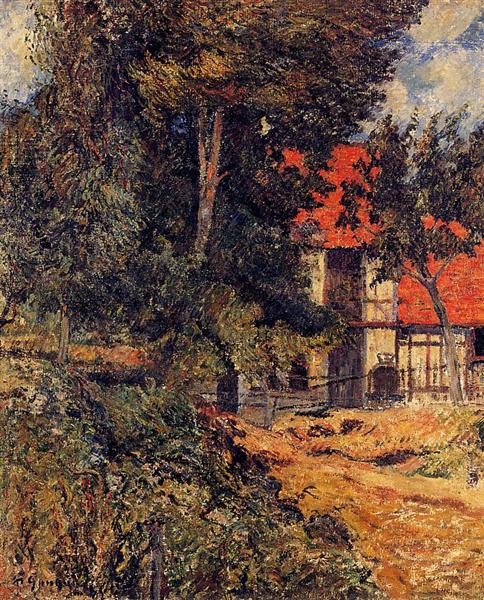विवरण
Paul Gauguin's "Stable Near Dieppe" (1886) represents a significant moment in the artist's career, already displaying the characteristics that would make him famous in the Post-Impressionist movement. In this painting, Gauguin captures a tranquil, pastoral scene that refers to French rural life, a theme he passionately explored at various points in his career. The choice of Dieppe as the location for this depiction resonates with his interest in the Norman landscape and peasant life.
Visually, the composition is dominated by a palette of greens and browns, evoking both the richness of the countryside and an atmosphere of calm and serenity. The shape of the stable, which occupies the central part of the work, suggests a refuge for both the animals and the elements of the environment. In its construction, Gauguin uses straight lines and angles that offer a sense of solidity and permanence, contrasting with the nature that surrounds it. The stable is presented as a robust but not rigid structure, where the earthy colours subtly integrate with the natural context.
What is striking about this work, however, is the absence of human or animal figures, a striking fact in a painting that could have been populated by rural life. This artistic decision is not trivial; it suggests an introspection about the environment and an invitation to contemplate the landscape itself. The connection between man and nature is often explored in Gauguin's work, and in this piece he seems to hint at a life in harmony, yet peaceful in its solitude.
The treatment of colour is another fundamental aspect of "Stable Near Dieppe". Gauguin applies an almost flat technique, reminiscent of his contemporaries in post-impressionism, such as Vincent van Gogh. The absence of marked shadows and the softness of the chromatic transitions give the scene an air of visual immediacy that invites the viewer to enter into an almost dreamlike experience. This use of colour moves away from naturalistic representation, leaning towards a more symbolic and emotional interpretation of space.
The work can also be contextualized within his contemporary output, in which Gauguin was beginning to explore themes that went beyond the simple representation of the outside world. His later works, especially those he made after his trip to Tahiti, are characterized by a bolder use of color and more simplified forms, indicating a path toward abstraction and the exploration of symbolism. "Stable Near Dieppe" can be considered, in this sense, a turning point; a place where realism and emotionality still meet, reflecting his transition toward the more modernist approach that would characterize him.
Through this work, Gauguin not only paints a rural landscape, but also offers us a mirror in which to reflect on the relationship between humans and their environment. The etablido near Dieppe, although lonely, serves as a witness to the life that, although not present, is felt in the air. The work is a testament to Gauguin's talent for capturing the essence of a place, and at the same time, an invitation to explore his sense of belonging and the search for beauty in the everyday. Ultimately, this painting stands as a fundamental piece in the study of post-impressionism, highlighting the path that the artist would follow and the impact he would have on contemporary art.
KUADROS ©, a famous painting on your wall.
Hand-made oil painting reproductions, with the quality of professional artists and the distinctive seal of KUADROS ©.
Painting reproduction service with satisfaction guarantee. If you are not completely satisfied with the replica of your painting, we will refund 100% of your money.

